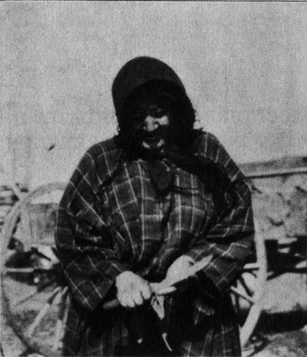My friend Mart Hale just pointed me to a bulletin from the University of Minnesota titled Buffalo Bird Woman’s Garden.
I’m posting an excerpt here – it’s totally fascinating.
Excerpt from Chapter 1 of Buffalo Bird Woman’s Garden:

Buffalo Bird Woman
“We Hidatsas believe that our tribe once lived under the waters of Devils Lake. Some hunters discovered the root of a vine growing downward; and climbing it, they found themselves on the surface of the earth. Others followed them, until half the tribe had escaped; but the vine broke under the weight of a pregnant woman, leaving the rest prisoners. A part of our tribe are therefore still beneath the lake.
My father, Small Ankle, going, when a young man, on a war party, visited Devils Lake. “Beneath the waves,” he said, “I heard a faint drumming, as of drums in a big dance.” This story is true; for Sioux, who now live at Devils Lake, have also heard this drumming.
Those of my people who escaped from the lake built villages near by. These were of earth lodges, such as my tribe built until very recent years; two such earth lodges are still standing on this reservation.
The site where an earth lodge has stood is marked by an earthen ring, rising about what was once the hard trampled floor. There are many such earthen rings on the shores of Devils Lake, showing that, as tradition says, our villages stood there. There were three of these villages, my father said, who several times visited the sites.
Near their villages, the people made gardens; and in these they planted ground beans and wild potatoes, from seed brought with them from their home under the water. These vegetables we do not cultivate now; but we do gather them in the fall, in the woods along the Missouri where they grow wild. They are good eating.
These gardens by Devils Lake I think must have been rather small. I know that in later times, whenever my tribe removed up the Missouri to build a new village, our fields the first year, were quite small; for clearing the wooded bottom land was hard work. A family usually added to their clearing each year, until their garden was as large as they cared to cultivate.
As yet, my people knew nothing of corn or squashes. One day a war party, I think of ten men, wandered west to the Missouri River. They saw on the other side a village of earth lodges like their own. It was a village of the Mandans. The villagers saw the Hidatsas, but like them, feared to cross over, lest the strangers prove to be enemies.
It was autumn, and the Missouri River was running low so that an arrow could be shot from shore to shore. The Mandans parched some ears of ripe corn with the grain on the cob; they broke the ears in pieces, thrust the pieces on the points of arrows, and shot them across the river. “Eat!” they said, whether by voice or signs, I do not know. The word for “eat” is the same in the Hidatsa and Mandan languages.
The warriors ate of the parched corn, and liked it. They returned to their village and said, “We have found a people living by the Missouri River who have a strange kind of grain, which we ate and found good!” The tribe was not much interested and made no effort to seek the Mandans, fearing, besides, that they might not be friendly.
However, a few years after, a war party of the Hidatsas crossed the Missouri and visited the Mandans at their village near Bird Beak Hill. The Mandan chief took an ear of yellow corn, broke it in two, and gave half to the Hidatsas. This half-ear the Hidatsas took home, for seed; and soon every family was planting yellow corn.
I think that seed of other varieties of corn, and of beans, squashes, and sunflowers, were gotten of the Mandans afterwards; but there is no story telling of this, that I know.
I do not know when my people stopped planting ground beans and wild potatoes; but ground beans are hard to dig, and the people, anyway, liked the new kind of beans better.
Whether the ground beans and wild potatoes of the Missouri bottoms are descended from the seed planted by the villagers at Devils Lake, I do not know.
My tribe, as our old men tell us, after they got corn, abandoned their villages at Devils Lake, and joined the Mandans near the mouth of the Heart River. The Mandans helped them build new villages here, near their own. I think this was hundreds of years ago.
Firewood growing scarce, the two tribes removed up the Missouri to the mouth of the Knife River, where they built the Five Villages, as they called them. Smallpox was brought to my people here, by traders. In a single year, more than half my tribe died, and of the Mandans, even more.
Those who survived removed up the Missouri and built a village at Like-a-fishhook bend, where they lived together, Hidatsas and Mandans, as one tribe. This village we Hidatsas called Mu’a-idu’skupe-hi’cec, or Like-a-fishhook village, after the bend on which it stood; but white men called it Fort Berthold, from a trading post that was there.
We lived in Like-a-fishhook village about forty years, or until 1885, when the government began to place families on allotments.
The agriculture of the Hidatsas, as I now describe it, I saw practiced in the gardens of Like-a-fishhook village, in my girlhood, before my tribe owned plows…” (Read more here!)
 After starting to read the text online, I thought “I need to see if this has been printed as a book!”
After starting to read the text online, I thought “I need to see if this has been printed as a book!”
It has been and you can find it here.
I just bought a copy, since the agricultural techniques and the history are completely fascinating.
It even seems that the Hidatsas used seed balls in their growing.
Nice find, Mart.


3 comments
Yes, this is fascinating, David. Thank you for posting this.
Also, what is your favorite mulberry variety? I live in south Sarasota County.
I like Illinois Everbearing quite a bit. Also, any improved black variety.
Looks like a great find! Thank you for letting us know! I have a mulberry tree, and was told it could only be reproduced one way. (Don’t remember what that was.) I thought about it: it has the fruit which must have seeds in it, plus it must be cutting-able. One of the leaves, with stem, was falling off the tree. I gave it some rooting hormone and planted it. That was last spring. It is growing and actually producing a few mulberries! So exciting! Haven’t tried the fruit…too yummy to plant :)
Comments are closed.